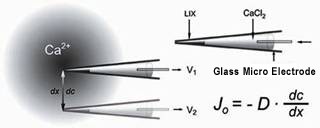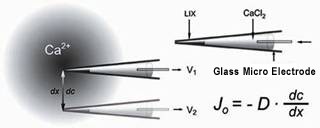We love to answer questions about our technology (NMT) so we've decided to feature some of our most popular inquiries about flux. Flux is one of the unique features that makes NMT so special, and we are excited to share the details with you!
Q: What is flux?
A: There are different definitions of flux in different areas. Here it is defined as: Diffusion flux, the rate of movement of ions/molecules across a unit area, in units of picomoles/cm2/second OR femtomoles/cm2/second depending on your chosen ions/molecules.
Q: What is the physiological significance of flux?
A: There are many answers to this question. Let's start with an example: When measuring oxygen flux in a leaf sample with different levels of light, the oxygen flux is significant because it represents the rate of photosynthesis. In fact, oxygen is a useful measure of metabolic activity in all living samples!
However, we don't only measure oxygen, and leaves are just one idea for a sample. We currently have 12 ion/molecule flux sensors available, and our customers have applied them in a huge variety of fields, from salt stress in plants, to neuroscience, to cancer metabolism, to environmental science and more. So potentially, there are a lot of answers to this question! However, there is one thing that unifies all of this research: physiology. Since NMT measures live samples with minimal damage or interference, the flux data almost always represents a physiological function of the sample.
To find the answer for your particular field, we have tons of Applications compiled already, and if it's not there, check out our Publications. If no one has done it yet, then you could be the first! Check out our NMT Physiolyzer® to become a pioneer of flux research in your field.
Q. What makes your flux sensors different from other ion or molecule sensors?
A: There are two parts to this answer: sensitivity and dynamic measurement.
Firstly, the NMT flux sensors have higher temporal sensitivity than many other traditional sensors, meaning that they can take a measurement very quickly.
Secondly, they are not just measuring concentration, they are measuring dynamic diffusion flux (the rate of movement). During testing, a flux sensor moves between two points, taking a measurement each time. Those measurements are used to calculate the movement of ions or molecules; Fick's Law of Diffusion (see below) is used to calculate if the sample is releasing (efflux) or taking in (influx) the measured ion or molecule. This calculation is done automatically by the system, and the flux is plotted on screen for you to watch in real time.
Q: If you need to be measuring two points, why don't you just use two sensors?
A: If each sensor were 100% identical, then using two sensors would be a great idea. As it is, two sensors are bound to have tiny differences, so here is the brilliant part: Lionel Jaffe, innovator of the vibrating probe technique, realized that if you use just one probe and move it between two points, the ONLY difference will be the true difference in concentration, and you can therefore measure the flux. This concept means that even if the sensor is measuring the wrong concentration, the flux will still be accurate.
If you have more questions about NMT, we would love to give you some answers! Contact us to learn more.
To read even more FAQs, check out our full list here.
Check Out More Applications NMT's most popular field is currently plant physiology, but creative scientists are applying it to new fields every day, like diabetes and cancer research. Now, labs using NMT systems have published over 700 papers in top journals! Our clients' top feedback is that the their high-quality results help them get published, thanks to the non-invasive nature of our technology, which allows them to measure live, physiologically accurate samples.
Experience the NMT Physiolyzer® Our most advanced NMT system yet: This highly advanced instrument is allowing scientists to discover physiological functions of live samples in innovative new ways. With customizable software, you can choose from 12 ions and molecules for your own personalized system.
The Theory of NMT Check out the principles of how NMT works.




